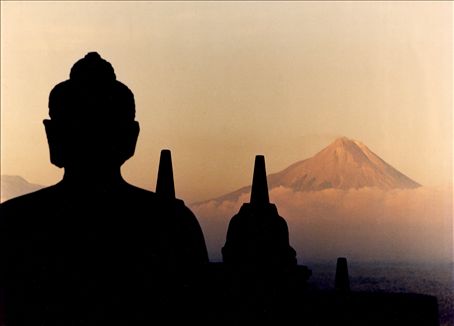Borobudur
I often dream of visiting Borobudur (circa 1770 AD – 1850 AD) in Java. The photographs show a giant pyramidal, tiered stone monument adorned with many large seated Buddhas (in Mahayana Buddhism there are a number of figures who reached enlightenment but only one historic Buddha – Siddhartha Gautama). Borobudur lies in the fertile Kedu plain encircled by an impressive scenery of mountains and volcanoes.
It must be said that I was slightly disappointed when I saw two of the Buddha heads from the monument in the British Museum in London. The heads are made from a much darker stone than I had envisaged – a volcanic andesite perforated all over with little holes. However, I believe the overall affect, when seen in its luscious Javanese setting must simply take ones breath away – its scale and solitude alone would express a profound sense of the holy. A visitor to Borobudur in the early 20th century wrote his impressions on the monument:
‘A night with Boro Budoor is a night of purification, when Amitabha offers the lotus of the good law and the gift is accepted; when the wonderful edifice, rising to the star-spangled sky, unfolds terrace after terrace and gallery after gallery between the domed and pinnacled walls, as his flower of ecstatic meditation spreads its petals, opens its heart of beauty to the fructifying touch of heaven; when love tranquil descends in waves of contentment, unspeakable satisfaction.’ (Scheltema, 1912: 271)Praise indeed! Aside from being a great artistic achievement Borobudur is also rather mysterious. To this day no one quite knows what its intended purpose was. Is it a mandala (a magical square, or a sacred place)? Or is it a stupa (a building containing the holy relics of the Buddha)? The monument is composed of six square terraces topped by three circular terraces, in the form of a mandala.
The four square terraces are lined with relief panels – beginning with cautionary tales (Karmavibhanga) illustrating the punishments wrong-doers will face and the rewards for those who follow a dharmic (righteous) life. Next come the Jatakas – stories from the life of the historic Buddha, and Avadenas – stories from the lives of Bodhisattva’s. The next series of reliefs tell the story of the spiritual journey of the merchant Sudhana. In the last section he meets the supremely wise Samanthabhadra and there after one is led onto the circular terraces where there is a sudden clarity and spaciousness. The uppermost terrace is crowned with a large stupa – many smaller stupas punctuate the two terraces beneath it.
A stupa containing a relic of the Buddha would be as powerful and significant to a disciple as standing before the Buddha in his bodily form. Stupa’s also remind us of the Buddha’s enlightenment and his earthly teachings before he left for nirvana. Stupas echo the form of a hill and thus are said to represent Mount Meru – the abode of the gods and the centre of the universe. In one Buddhist text – the Lotus Sutra – it is said that after Buddha meditated on the Mount of Eagles he told his disciples why he had led them to believe that there are three paths to salvation when in fact there is only one. It was necessary, he said, because it gave greater breadth for people at different spiritual levels. After he had spoken, a great seven jewelled stupa appeared out of mid air and hovered above the ground.
“welling up out of the earth and resting in mid-air. It had five thousand banisters, a thousand myriad’s of grotto-like rooms, and numberless banners to adorn it … Its height extended to the palaces of the four god kings.” (Miksic, 1990: 54)
Thus the central stupa at Borobudur could be based on the one described in the Lotus Sutra. This is only one of the many possible meanings of this great edifice. No doubt it was a place of pilgrimage and taking the journey from the base of the monument to the upper terraces was probably intended to be both a metaphorical and actual spiritual experience – another step along the journey towards enlightenment.
Marvelling at this Buddha with his upright head rising above the mountain tops on the horizon and seemingly grazing the sky, I can really understand why art and religion have always been so closely entwined because an image often speaks so much more directly to the heart and soul of man than words.









thanks Lakshmi for these wonderful mind refreshing articles
and lovely pictures
Wow! Another place that must be amazing! I have just seen the post on Angkor vat and later something about a village near Borobudur, called Candirejo, for a seminar paper about community based tourism. If anyone is interested to know about, or may be to go there: http://www.central-java-tourism.com/desa-wisata/en/candirejo.htm
Since writing this post I have, bizzarly, come across two more Buddha heads from Borobudur. One in the Grunesgewolbe museum in Dresden, and one at the museum of Asian art, Berlin. The Dresden Buddha head is more beautiful than the ones in the British Museum collection.
Awesome!
Beautiful pictures! I recently came from my first visit to Borobodur, it was stinking hot and I got a terrible sunburn, but I had an amazing day! The temple is mind blowing; I love how it is designed around a mandala pattern. Apparently you used to be aloud to reach inside the stupas and if you could touch the Buddha’s hand you would be granted good luck, but these days it is not allowed.